Is Frozen Yogurt Healthier Than Ice Cream? Well, Not Really.
#30DaysofSugar
Myths About Frozen Yogurt, BUSTED
Swirl with caution! There’s a long held belief that frozen yogurt is better for you than ice cream, and why wouldn’t there be? After all, whenever you head into a fro-yo shop you’re bombarded with signs saying ‘sugar-free’, ‘low fat’, and ‘loaded with probiotics for gut health’. But are these claims actually true, and is frozen yogurt healthier than ice cream? In this post I’ll get into the details surrounding the ice-cream vs froyo debate (no, frozen yogurt is not always low-sugar or sugar-free) and the dangers of frozen yogurt to your health.
Swirl with caution! There’s a long held belief that frozen yogurt is better for you than ice cream, and why wouldn’t there be? After all, whenever you head into a fro-yo shop you’re bombarded with signs saying ‘sugar-free’, ‘low fat’, and ‘loaded with probiotics for gut health’. But are these claims actually true, and is frozen yogurt healthier than ice cream? In this post I’ll get into the details surrounding the ice-cream vs froyo debate (no, frozen yogurt is not always low-sugar or sugar-free) and the dangers of frozen yogurt to your health.
It’s swirl time!
Ahh… it’s a hot day, and all you can think about is a cold scoop of ice cream.
You’re craving something sweet, but it’s the middle of the week (not a cheat day) and you want to stay healthy and away from refined sugars.
You decide that you’ll go for a healthier option and pop over to your local fro-yo shop to get a yummy swirl of vanilla frozen yogurt, knowing that you’re taking a healthier step in life.
BUT, is frozen yogurt really healthier than ice cream, or is it too good to be true?
Lo siento my friends, but NO.
It’s time to get into the cold truth hard truth behind frozen yogurt’s chilly myths (see what I did there?).
Yogurt by nature only needs to made from curdled milk and cultures, but many frozen yogurt brands and companies usually PACK their frozen yogurt with sugar and un-pronounceable ingredients.
Don’t worry if you did think that your cup of frozen yogurt is a healthy treat, you’re not alone.
Market research has shown that the sale of frozen yogurt has risen an average of 21 percent each year since 2008, and according to a survey conducted by Menchies, around 95 percent of Americans believe our frozen friend frozen yogurt is better for their health than ice cream (including yours truly, for a time).
An average yogurt self serve container can hold around 16 to 24 ounces, and the frozen yogurt it contains averages around 100 calories per 1/2 cup. So, if you decide to fill up your cup to the top, depending on the ounces, you might accidentally be eating more than 510 calories.
If you add any sweet toppings - like your favourite gummies or crushed Oreos - you’re heading way out of the low-calorie city limits.
Okay, you may be thinking, it may not be a low calorie food, but is frozen yogurt healthy for you?
Is frozen yogurt healthier than ice cream?
Well, before I answer any of these questions (and talk about whether frozen yogurt is healthy at all), we should probably cover a little bit what about the differences between frozen yogurt and ice cream actually are.
What is the Difference Between Frozen Yogurt and Ice Cream?
The Dairy:
By definition, ice cream must have 10 percent milk-fat, normally meeting this requirement by adding cream. Fro-Yo is a bit different. Frozen yogurt is made from cultured milk instead of cream, and there is no fat requirement.
Is the dairy in frozen yogurt good for gut health?
Even though cultured milk is the main dairy ingredient in frozen yogurt, the cultures don't usually survive being frozen, so the beneficial bacteria probiotic that aids in digestion which is normally found in yogurts and fermented foods won’t be of any benefit in your frozen yogurt.
To make up for it manufacturers of fro-yo (and standard yogurt) will sometimes add extra probiotics after production.
So does that mean that frozen yogurt really is healthy?
Hold up, those added probiotics don’t mean your frozen yogurt is automatically healthy - there are other sneaky dangers to watch out for, including SUGAR.
Yes, I know that many fro-yo chains often advertise their frozen yogurt as healthier and lower in sugar than ice cream, but that’s not really true.
Actually, it’s the opposite: FROZEN YOGURT often has MORE SUGAR than ice cream.
Is frozen yogurt low in sugar? The hidden sugar content in frozen yogurt.
A half-cup serving of frozen yogurt contains around 17 grams of sugar, while ice cream has about 14 grams for a half-cup serving.
Companies like to add extra sugar to get rid of the natural tart taste of yogurt and to prevent large ice crystals from forming, ensuring a texture like ice cream. This is especially the case for nonfat and low-fat versions of frozen yogurt, which tend to contain even more sugar to make up for that lack of fat.
I would say that the largest nutritional difference between frozen yogurt and ice cream is the fat content.
A regular cup of vanilla ice cream contains around 270 calories, 15 grams of fat, and 9 grams of saturated fat, while a cup of regular vanilla frozen yogurt contains 221 calories, 6 grams of fat and 4 grams of saturated fat.
But the fact that ice cream has more fat doesn’t necessarily make it worse. That fat can help slow your body’s digestion of the sugar, helping you feel satisfied and preventing a bad blood sugar spike - like the one you’ll experience with fro-yo. So no, frozen yogurt is not generally healthier than ice cream.
Frozen yogurt is also highly processed.
To make is worse, frozen yogurt brands also add nasty processed additives and sugar substitutes that can cause digestive issues like bloating or cramping.
Yes, frozen yogurt can cause bloating.
If you follow my blog you probably know my favourite rule when it comes to reading a food label: if there is an excessive amount of ingredients - and some of which you can’t pronounce - don’t buy it! Your body is your temple, don’t risk it.
The dangers of frozen yogurt.
Unless your fave frozen yogurt shop or brand is certified organic, which most aren’t, they are adding ANYTHING they want to it. It’s likely that your fro-yo cup is full of artificial additives, artificial sweeteners, antibiotics, GMOs, carrageenan and weird unnerving food colorings!
I literally felt sick after I researched what was in my cup of fro-yo from Pink Berry, but I'll get to that in a sec. First, let’s talk about those aforementioned additives, and I’ll start with the antibiotics.
Antibiotics in Frozen Yogurt
Most of big brands of frozen yogurt, like Pinkberry and TCBY, use dairy that has not been certified organic.
This means when we eat their frozen yogurt, we are at risk of consuming potential antibiotics and growth hormone, which they inject cows with. The reason they use antibiotics is because they feed the cows corn instead of grass, which causes the cow to be sick.
They use the growth hormone to help the cows get larger for when they’re ready to use their meat, and they also likely feed these cows genetically modified feed. So cruel!
This is what conventional dairy farms do to their cows, and these antibiotics and growth hormones pass down to us through the milk, which can cause many health problems - and even cancer.
Artificial (and ‘Natural’) Ingredients in Frozen Yogurt.
Many frozen yogurt cups also contain both artificial and natural ingredients (and although they’re called natural, they may not be so naturally great for your HEALTH).
To name a few weird additives common in fro-yo: aguar gum, maltodextrin, sodium citrate, cellulose gum, disodium phosphate and propylene glycol monoesters.
Also, one of the ‘natural’ ingredients is carrageenan, a thickener made from red seaweed, which has been associated with side effects negative to your health, like inflammation, bloating, irritable bowel syndrome and IBD.
Oh, and some of those natural berry fro-yo flavors come from castoreum, an extract originating from beaver perineal glands (a gland that secretes an odorous substance for territory marking - often located near the animal's anus).
Some red food coloring's that are used in cherries, candy, and baked treats, and fro-yo can cause thyroid tumors in rats, and may also cause them in humans. And if you thought that was enough, well it’s also linked to hyperactivity in children.
All of these chemicals and additives can do potential harm, so please watch your consumption.
Sugar and Artificial Sweeteners in Frozen Yogurt.
Aaanndd the list gets worse!
On top of regular sugar, many brands use the toxic genetically engineered corn syrup and other processed sugars in their yogurt.
Sugar alcohols like mannitol, xylitol, erythritol, sorbitol, and maltitol can cause some scary gastrointestinal side effects, like bloating, gas, abdominal pain and diarrhea.
💩 Your frozen yogurt may give you diarrhea - that’s a whole other kind of swirl.
Even though these effects don’t normally happen until you consume around 50 grams of these nasty sugar alcohols, it is possible for them to occur after eating ONLY 10 grams.
To make it even worse, all of that sugar in your fro-yo can be hidden on the ingredient list under a whole host of sneaky names, making it harder to spot: fructose, dextrose, corn syrup, high fructose corn syrup, juice concentrates, fructose, polydextrose, pure cane sugar and the list goes on.
Processed sugar can ruin your skin, cause weight gain, and create inflammation in the body, resulting in ailments like asthma, arthritis, or even cancer.
Another useful thing to know is that the ingredients list of any food lists ingredients in order of their abundance.
Sometimes manufacturers use certain sweeteners because of sourcing or cost, but it’s also their sneaky way from keeping sugar from being at the top of the ingredients list as the sugar product will be listed by multiple different names.
Just to give you an example, check out the ingredients of my of favourite PinkBerry Cinnamon Churro Yogurt:
NONTART FROZEN YOGURT (nonfat milk, sugar, nonfat yogurt [pasteurized nonfat milk, pectin, live and active cultures] or [pasteurized nonfat milk, pectin, live and active cultures], nonfat yogurt powder [nonfat milk, culture], dextrose, carrageenan, guar gum, maltodextrin, mono- and diglycerides, rice starch), CINNAMON CHURRO FLAVOR (brown sugar, enriched bleached flour [bleached wheat flour, niacin, reduced iron, thiamine mononitrate, riboflavin, folic acid], enriched wheat flour [contains niacin, reduced iron, thiamine mononitrate, riboflavin, folic acid], graham flour, sugar, palm oil, brown sugar, honey, salt, baking soda and artificial flavor, natural whole grain rolled oats, unsalted butter [pasteurized cream], canola oil, water, cinnamon, release agent [contains soy lecithin], pure cane sugar, water, vanilla extract, vanilla bean specks, gum tragacanth [vegetable based thickener])
Can you even read any of that?
How to find the nutritional content in your frozen yogurt.
Ice cream and yogurt companies usually offer their nutritional information online, so use this as a resource and check it out before eating. If it has more than seven or so ingredients, don’t risk it.
And if you don’t recognize the ingredients? Don’t risk it.
So what’s the bottom line?
People trick themselves into thinking that frozen yogurt is healthy, making portion control a problem. Even a small cup will rack up the calories, load up the SUGAR - that not even to mention all that comes with the toppings.
Let’s not forget that most frozen yogurt isn’t organic, and is loaded with toxic additives, artificial and weird natural ingredients, and antibiotics from the cow milk!
I hope you see how sneaky sugar is, and I really hope for your health’s sake that you be wary of processed foods.
Food companies don’t normally care about our health. They make out that a food product is healthy when it’s not and hide sugar so we keep on coming back for more. This means that you could accidentally buy a healthy food containing sneaky sugars that causes you a sugary cravings cycle.
Added sugars aren't a necessary nutrient in your diet, and they can cause serious harm if eaten in large amounts on a regular basis - especially processed sugar.
I’ve been through my own journey - a miserable sugar obsession, health problems, self-confidence breakdown and miserable pains - but I have come out a person who can control what she eats, and a healthier, balanced, happier person in general for it. Most people are obsessed with to sugar, like you and I, but something is preventing them from breaking the spiral:
• They don’t realize how much sugar they actually consume
• They don’t believe that their sugar consumption is tied to an obsession
• They’ve tried to quit eating sugar but found it too hard
To learn more about your sugar cravings, check out my blog post: Why You Are Obsessed With Sugar (& How To Fix It) or send me a message on Instagram for some support (you can even use the little yellow messenger box in the right corner of this page). Remember, you can also join my free Facebook group ‘Sugar Balanced Living’ for more support and tips!
The Frozen Yogurt Dos and Don’ts
What we have to do is take a stand, read thoroughly through ingredients, memorize those hidden sugars and try and prepare your own home cooked meals when we can - it’s always best to know exactly what you’re eating. There are plenty of recipes for home-made frozen yogurt (like this one).
Of course, I'm not saying to give up traditional frozen yogurt altogether - I totally believe in sugar balance.
Have frozen yogurt occasionally, and see it as a portion-controlled dessert instead of a healthy substitute. But I do hope you choose an organic frozen yogurt.
Here are 5 tips for your next trip to the fro-yo store:
1. Don’t fill your cup to the top.
Keep within an okay calorie range around 1/2 cup, and top it off with a bunch of fruit, dark chocolate or nuts.
2. Eat it slowly and savor the taste.
So you won’t be tempted to go back for more swirls (you can check out my free mindful eating exercise workbook to help with this).
3. Choose an organic frozen yogurt.
OR find a fro-yo that has real ingredients, and doesn’t have a massive list of preservatives or thickening agents.
4. Consider making your own fro-yo.
This will give you more control over the ingredients and calories in your treat. There are lots of great and simple recipes out there (like the one I linked above).
A sugar free and yummy frozen yogurt recipe I like to use: 1 cup Greek yogurt full-fat, 1 cup raspberries frozen, 1 Tbsp. coconut oil, 2 drops of liquid vanilla creme stevia extract to taste and a pinch of salt - blend it up and freeze.
5. If you want a super simple healthy yogurt treat, choose a plain yogurt.
This will give you all the health benefits without the added sugar, and top it with fruit or a sprinkle of cocoa or cinnamon. For a higher protein content opt for plain Greek yogurt.
Oh… and if you are trying to stop consuming so much sugar and have problems with sugar cravings head over to my post on When You Should Stop Eating Sugar + How To Do It - it’s full of to help you crush sugar and still enjoy life - with all it’s treats it has to offer!


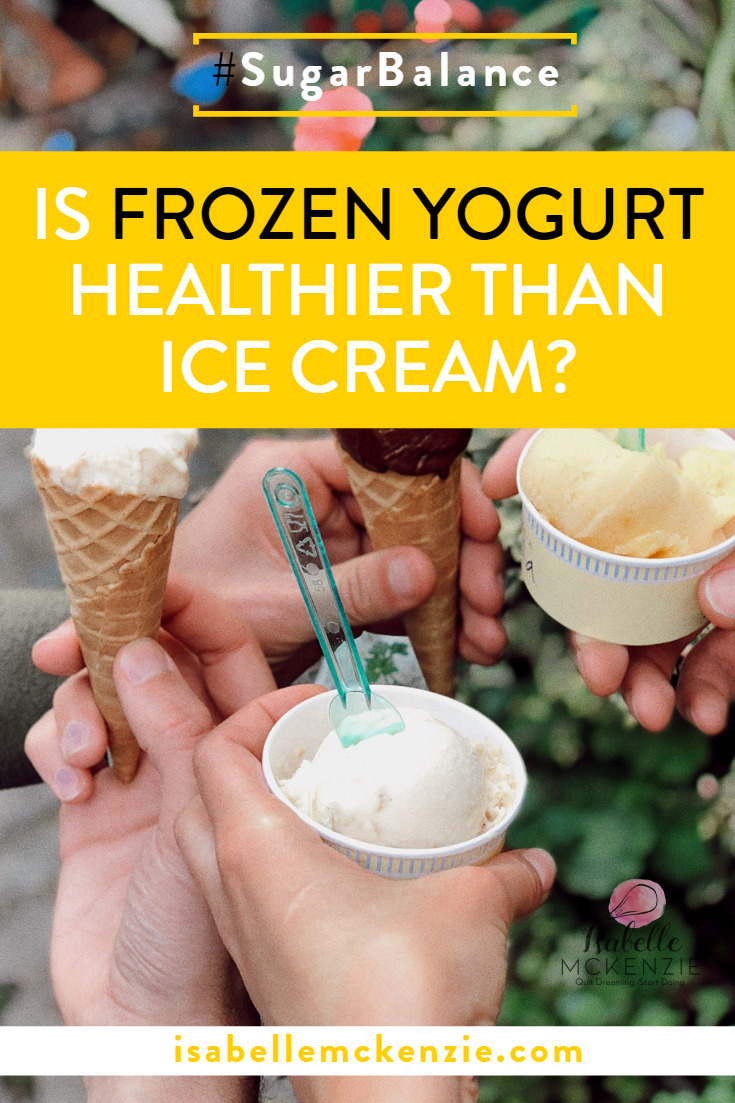


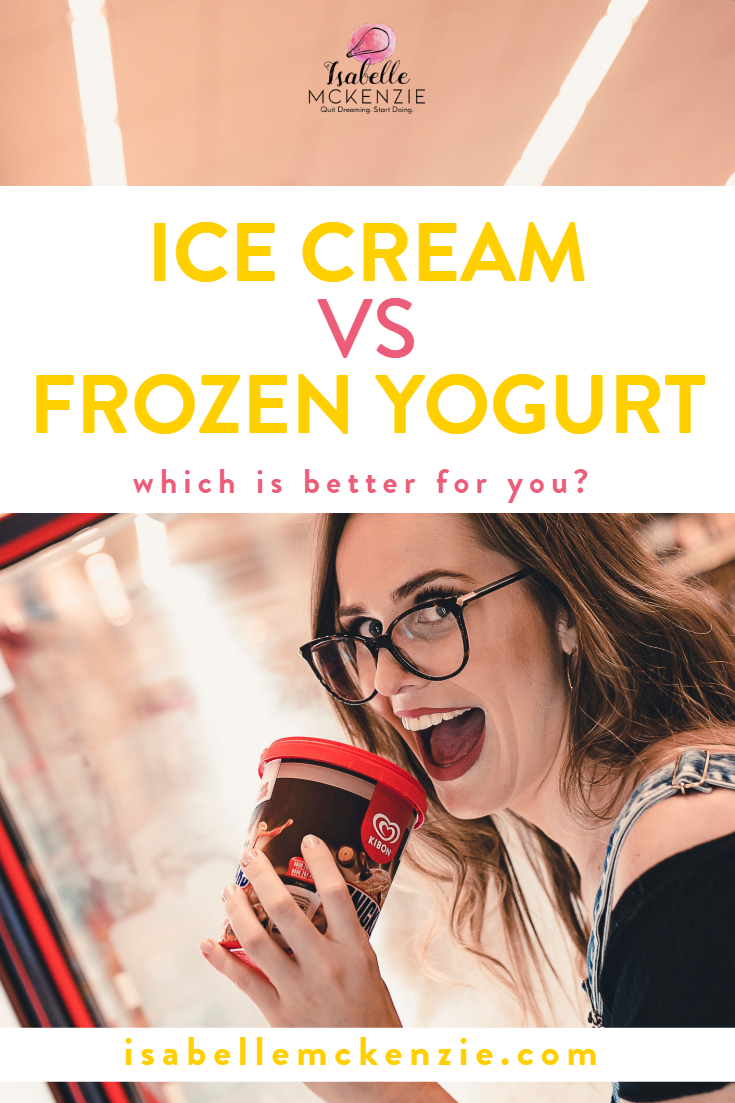
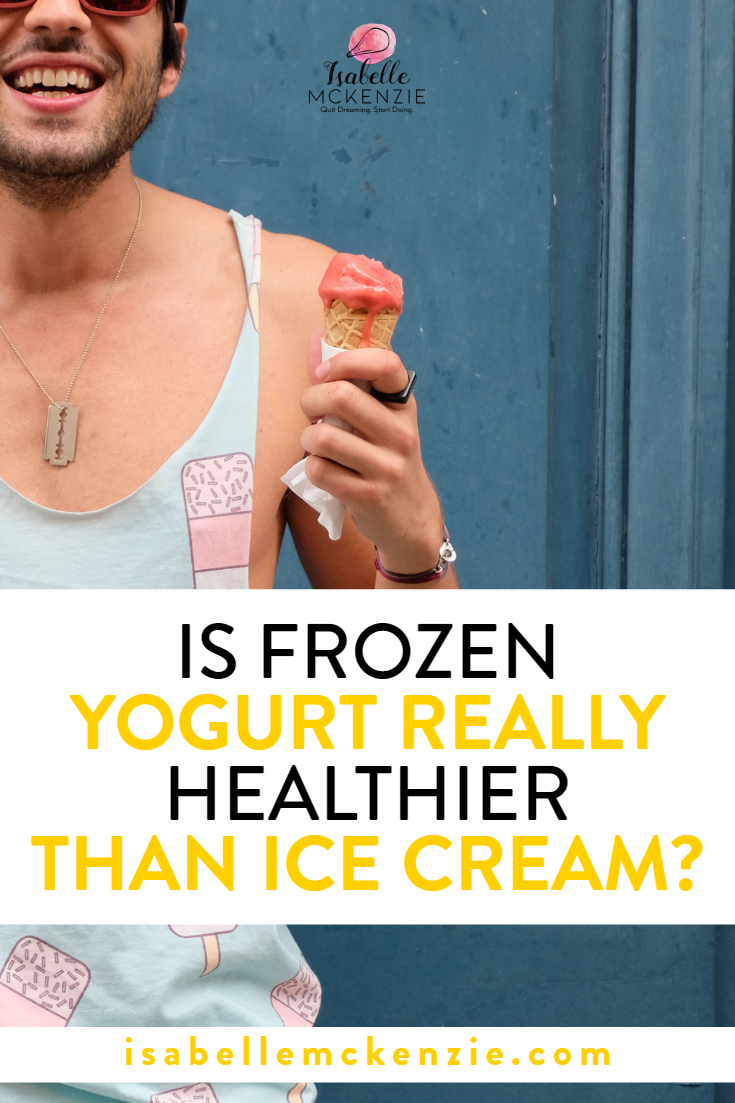

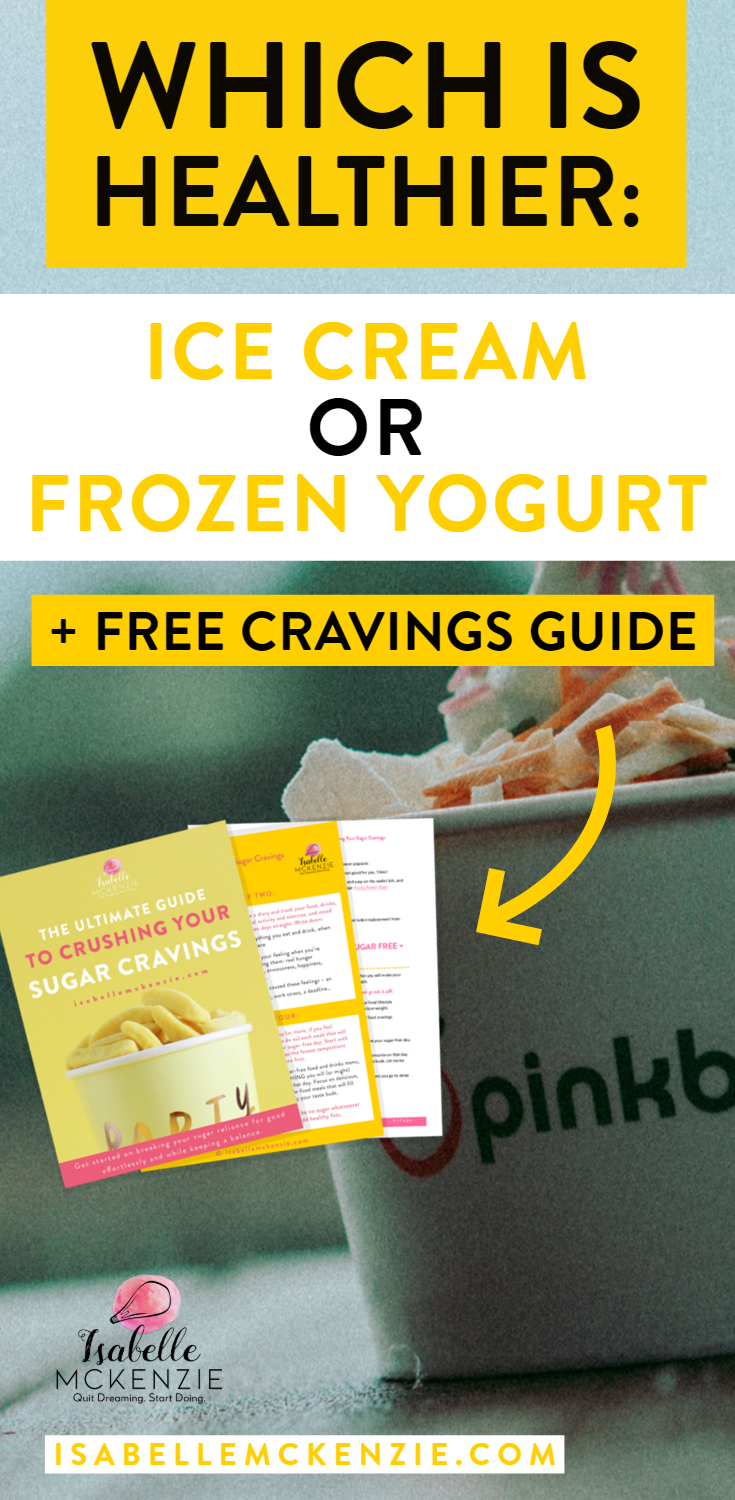








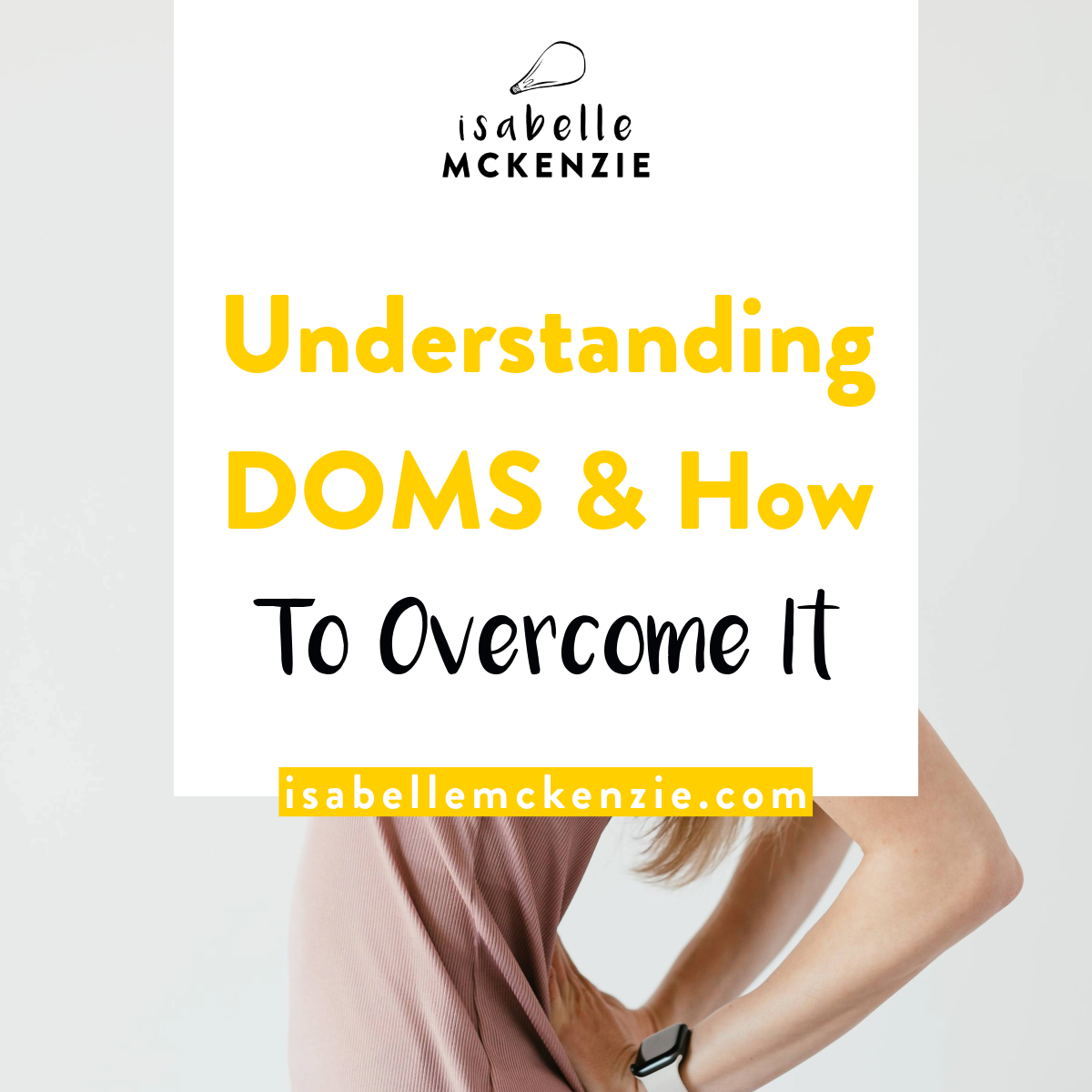






… yup, the Isabelle behind the IsabelleMcKenzie.com!
Instagram: @ItsIsabelleM | Pinterest: @ItsIsabelleM | Subscribe on Youtube
I’m dedicated to helping teach people how to live their happiest, healthiest life and reach their goals so that they can create the lifestyle of their dreams with integrity & purpose.
I focus on self-care, mind, body and health, dedicated to helping teach peeps how to live their happiest, healthiest life and reach their goals so that they can create the life that will have them jumping out of their bed in the morning to actually live!
Read More >